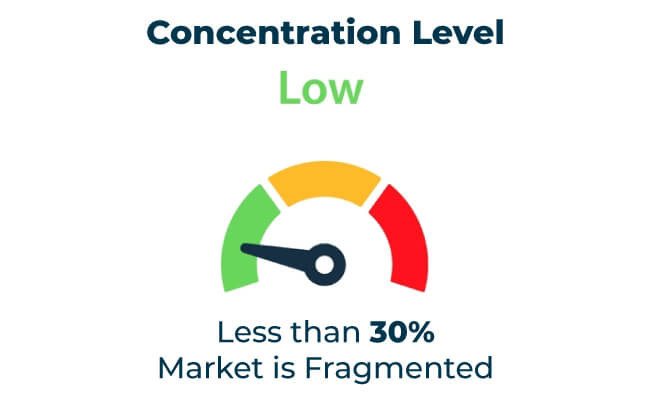As sustainability becomes central to consumer preference and regulatory policy, the market for bamboo straws is picking up. In this regard, companies like Bambaw, StrawFree, and Jungle Straws are changing the game by presenting eco-friendly reusable alternatives to plastic straws used once and disposed of.
Market size will surpass USD 8.1 billion by 2035, growing at a compound annual growth rate of 5.0%. This is aside from environmental conservation drives; there's an ever-widening global outcry about reducing plastic use and intake of waste. Besides that, demand is increasingly in appeal for products being naturally biodegradable.
| Attribute | Details |
|---|---|
| Projected Value by 2035 | USD 8.1 billion |
| CAGR during the period 2025 to 2035 | 5.0% |
Explore FMI!
Book a free demo
With more than business people on their case to quit plastics and seek alternates with regard to using straw straws, bamboo is coming to their aid in getting what they all look for-be more natural biodegradable as alternatives.
The biodegradable, reusable, and fashionable straws are popularly used by environment-conscious individuals and businesses, hence widely used in the food and beverage, hospitality, and retail industries. The growth reflects the increasing trend of using sustainability in day-to-day activities without compromising on functionality and beauty.
Global Market Share & Industry Share (%)
| Category | Market Share (%) |
|---|---|
| Top 3 Players (Bambaw, StrawFree, Jungle Straws) | 13% |
| Rest of Top 5 Players | 08% |
| Next 5 of Top 10 Players | 04% |
Type of Player & Industry Share (%)
| Type of Player | Market Share (%) |
|---|---|
| Top 10 Players | 25% |
| Next 20 Players | 43% |
| Remaining Players | 27% |

Year-over-Year Leaders
Regional Compliance
One of the major export potential regions for bamboo straw manufacturers is Africa, Latin America, and Southeast Asia. High growth is observed in those regions regarding an increase in concerns over environmental matters as well as the beginning of eco-tourism development there.
The bamboo straw market exhibits strong regional variation. North America takes up 35%, with bans of plastic straws and increasing consumer knowledge. Europe covers 30% of the market, fueled by strict regulations as well as efforts to make the place more sustainable.
Asia-Pacific enjoys 25%, due to huge bamboo reserves available and increasing demand from consumers for a greener solution. The balance 10% is spread among emerging regions in Latin America and Africa, where new environmental movements coupled with tourism developments are promoting growth.
The food and beverage industry is the largest application sector, followed by hospitality and retail. Businesses in these sectors are increasingly adopting bamboo straws as part of their commitment to sustainability.
The bamboo straw market will expand with innovation, global expansion, and sustainability. The future of the industry will be shaped by companies that focus on quality, durability, and eco-friendly practices. Ethical sourcing and product customization investments will further fortify market positions.
Tier-Wise Vendor Classification
| Tier | Key Companies |
|---|---|
| Tier 1 | Bambaw, StrawFree, Jungle Straws |
| Tier 2 | GoSili, Simply Straws |
| Tier 3 | Buluh Straws, Totally Bamboo |
The bamboo straw market is on a strong growth trajectory as sustainability becomes a priority for consumers and businesses alike. Companies investing in innovation, ethical sourcing, and global market expansion will lead the way in shaping this eco-conscious industry.
Key Definitions
Research Methodology
This report integrates primary interviews, secondary research, and market modeling. Findings were cross-checked with industry experts and end-users.
Market Definition
The bamboo straw market includes the manufacture and distribution of reusable, biodegradable straws made of bamboo. Bamboo straws address the growing needs for sustainable yet fashionable alternatives to plastic straws.
The market is driven by rising demand for eco-friendly, reusable alternatives to plastic straws and stricter regulations on single-use plastics.
The bamboo straw market is expected to surpass USD 8.1 billion by 2035, growing at a CAGR of 5.0%.
Bambaw, StrawFree, and Jungle Straws are the key players in the market. They are known for innovation and sustainability efforts.
High production costs, durability concerns.
Sustainable Packaging Market Trends – Innovations & Growth 2025 to 2035
Specialty Pulp and Paper Chemicals Market Analysis – Growth & Forecast 2025 to 2035
Sublimation Paper Market Analysis – Growth & Demand 2025 to 2035
Wire Cage Pallet Collar Market Growth & Insights 2025 to 2035
Kraft Paper Machine - Market Outlook 2025 to 2035
Retail Paper Bag Market Analysis by Material, Product Type, Thickness and End Use Through 2025 to 2035

Thank you!
You will receive an email from our Business Development Manager. Please be sure to check your SPAM/JUNK folder too.